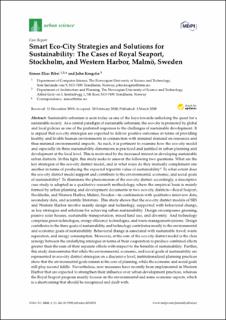| dc.description.abstract | Sustainable urbanism is seen today as one of the keys towards unlocking the quest for a sustainable society. As a central paradigm of sustainable urbanism, the eco-city is promoted by global and local policies as one of the preferred responses to the challenges of sustainable development. It is argued that eco-city strategies are expected to deliver positive outcomes in terms of providing healthy and livable human environments in conjunction with minimal demand on resources and thus minimal environmental impacts. As such, it is pertinent to examine how the eco-city model and especially its three sustainability dimensions is practiced and justified in urban planning and development at the local level. This is motivated by the increased interest in developing sustainable urban districts. In this light, this study seeks to answer the following two questions: What are the key strategies of the eco-city district model, and in what ways do they mutually complement one another in terms of producing the expected tripartite value of sustainability? To what extent does the eco-city district model support and contribute to the environmental, economic, and social goals of sustainability? To illuminate the phenomenon of the eco-city district accordingly, a descriptive case study is adopted as a qualitative research methodology, where the empirical basis is mainly formed by urban planning and development documents in two eco-city districts—Royal Seaport, Stockholm, and Western Harbor, Malmö, Sweden—in combination with qualitative interview data, secondary data, and scientific literature. This study shows that the eco-city district models of SRS and Western Harbor involve mainly design and technology, supported with behavioral change, as key strategies and solutions for achieving urban sustainability. Design encompasses greening, passive solar houses, sustainable transportation, mixed land use, and diversity. And technology comprises green technologies, energy efficiency technologies, and waste management systems. Design contributes to the three goals of sustainability, and technology contributes mostly to the environmental and economic goals of sustainability. Behavioral change is associated with sustainable travel, waste separation, and energy consumption. Moreover, at the core of the eco-city district model is the clear synergy between the underlying strategies in terms of their cooperation to produce combined effects greater than the sum of their separate effects with respect to the benefits of sustainability. Further, this study demonstrates that while the environmental, economic, and social goals of sustainability are represented in eco-city district strategies on a discursive level, institutionalized planning practices show that the environmental goals remain at the core of planning, while the economic and social goals still play second fiddle. Nevertheless, new measures have recently been implemented in Western Harbor that are expected to strengthen their influence over urban development practices, whereas the Royal Seaport program mainly focuses on the environmental and some economic aspects, which is a shortcoming that should be recognized and dealt with. | en_US |

